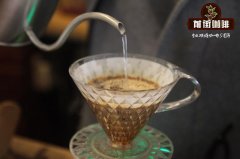Why is the espresso made at home so bad? It's a far cry from what you drink in a cafe.

Professional coffee knowledge exchange more coffee bean information please follow the coffee workshop (Wechat official account cafe_style)
Espresso _ espresso
I've been trying to make espresso at home for months, changing the coffee machine, beans and water. I have tried all kinds of methods, but to no avail! The coffee brewed is not as mellow as the one I drank in the cafe. "
Do you all have this kind of trouble? It doesn't matter, it's not natural to make bad coffee! This article is going to talk about the causes of bad coffee brewing, as well as adjustments and solutions.
In addition to feeling that the coffee tastes wrong, it should be difficult for beginners to describe exactly and specifically what the shortcomings are. A poor espresso lacks mellowness, leaving excessive bitterness and irritating acidity in the mouth, dry and astringent, insufficient or even without aroma, not to mention the aftertaste.
There is no middle ground for coffee, especially espresso. Think about it carefully, it can be the most simple raw materials, directly to high temperature and high pressure to quickly extract the essence! However, this method also has a disadvantage, that is, there are too many factors. In order to minimize the impact of cooking conditions, you should pay attention to the following points:
An espresso machine that has not been maintained for a long time, is in disrepair, or is in poor condition
Although espresso machines are becoming more and more common, not all espresso machines are equally good. A good machine should also have good maintenance procedures, especially coffee oil stains should not be attached to the internal parts of the machine, and the pipeline should also avoid scale deposition.
No bean grinder is used
Coffee beans are different from ground coffee powder in that they retain their flavor within a few days after they are opened, while once the coffee powder comes into contact with the air, the rapid oxidation process will make it lose its aroma in just a few minutes. Oxidized coffee powder can never make good coffee, so bean grinder and espresso machine are indispensable. The so-called bean grinder, or more precisely, a bean grinder with a grinding plate, can now grind out fine coffee powder to make our favorite espresso.
Use a bean grinder without maintenance or in poor condition
In the process of repeatedly crushing beans, the grinding plate blade is easy to wear, and it will also be stained with accumulated coffee oil (caffeine). Over time, even after fresh beans have been ground, the coffee will smell of fuel consumption. Regular maintenance of the bean grinder is as important as the coffee maker. See page 31 for how to maintain the bean grinder.
Fail to accurately grasp the extraction rate
In the process of high-pressure extraction of coffee, each condition has precise criteria and must be carefully and strictly enforced. Each step of adjustment is a perfect interpretation of the art of espresso for coffee makers. This requires skilled operation experience, coupled with the experience of several failures, you can better master the brewing conditions of espresso.
Coffee beans are of poor quality.
If coffee trees are in poor soil conditions and lack of careful care, the coffee beans harvested must not be amazing, and it would be nice to be able to brew a cup of coffee with a balanced taste. It is recommended to use high-quality coffee beans and consult experts if necessary. For coffee beans, see page 118.
Coffee beans are not roasted properly
Raw coffee beans are roasted at high temperatures, a process called "roasting". If it is not roasted enough, the espresso will be plain and sour; if it is overroasted, the coffee will be bitter.
Coffee beans are not fresh or too fresh
Coffee beans are roasted and sealed and packaged so that their aroma and texture can be preserved for months, but too long storage can still produce a fuel-consuming smell. Freshly roasted coffee beans are not suitable for brewing coffee immediately, because beans produce carbon dioxide during roasting, which may form large bubbles in the extracted coffee liquid. It is best to wait for a week, after the beans are "deflated", the espresso is not only better in flavor, but also less metallic.
Besides, do you know how to make a good cup of follicular coffee? Or, when you drink it, how do you taste it? Like espresso, follicular coffee deserves to be tasted and graded according to indicators. For a long time, follicular coffee has been regarded as a lower-grade coffee, but now it has been taken seriously again and it can also be regarded as vindication. Follicular coffee is more approachable than espresso in terms of hand-brewing skills and utensils price. However, we still have to follow certain techniques in order to brew out the follicular coffee that can withstand careful taste.
Temperature
Delicious follicular coffee will taste different tastes with the change of temperature. Greater than or equal to 70 ℃: the water temperature is high, the aroma can not be completely distributed, only part of the fragrance can be smelled. 60 ℃: the acidity and fruity taste of coffee gradually emerge. 40 ℃: the refreshing aftertaste is long and fragrant in the mouth. 25 ℃: if it's a good quality coffee, it tastes good even when it's cold.
With or without sugar?
Well-brewed follicular coffee can taste noble and meticulous levels, so there is no need to add sugar; on the other hand, if the quality of follicular coffee is poor or bad, it tastes bitter and difficult to taste, and the taste is inadequate. on the contrary, adding a little sugar can suit the overall taste and balance the flavor.
Use the senses
Compared with espresso, the quality and type of cup had little effect on the taste of follicular coffee. The color of coffee can be observed with a glass or transparent mug, and the roasting degree of coffee beans can also be judged by the color.
Deep roasted coffee beans: the coffee is dark in color and is dark brown close to black.
Light roasted coffee beans: the coffee will have a circle of light brown near red "coffee skirt".
Smell the smell
Follicular coffee should give off a pleasant aroma, with fruit, flower or nut flavors; if you smell other kinds of flavor, it is probably not a good smell.
Taste the taste
The most representative of the five flavors of follicular coffee is the sour taste. The refreshing sour taste brings fresh taste, coupled with fruity aromas, so that the coffee is layered. However, if the natural acidity of the coffee is too strong, it may also become uncomfortable (quinic acid can make the coffee astringent and disgusting acetic acid, etc.).
Aroma
Follicular coffee has a wider range of aromas than espresso and can be divided into the following types: flower, fruit, herbal, nutty, caramel, chocolate, medicinal plant, spice and tobacco. The smell of coffee smelled from the back of the nose in the mouth (wet fragrance), coupled with the smell directly through the nose (dry fragrance), will make the coffee more complete, but the smell before and after the nose is not necessarily the same (like espresso).
Alcohol thickness
Espresso is ten times stronger than follicular coffee, so the comparative concept of alcohol thickness is also very different. The alcohol thickness of follicular coffee comes from insoluble substances, which are still suspended in the coffee solution (precipitates and oils) after brewing in water, giving the coffee a thickness. Mellow thickness refers to the touch of coffee when it comes into contact with the tongue, which can be smooth, heavy, thick, light, thin or even as thin as water; and no matter whether the taste is strong or not, the coffee should make people feel happy.
Flavor
Follicular coffee is not as thick and sticky as espresso, which can be seen from its appearance. It is characterized by exquisite delicacy, suitable acid, just the right alcohol, coupled with the pungent aroma, lingering between the lips and teeth. Tasting follicle coffee is like a slow and long journey, and the infinite beauty along the way is fascinating with all kinds of details.
After reading the above little knowledge of tasting coffee and making coffee, I believe you will be able to know more about the delicious drink on hand from today on.
Espresso Coffee extraction detailed steps Italian concentration common sense
Important Notice :
前街咖啡 FrontStreet Coffee has moved to new addredd:
FrontStreet Coffee Address: 315,Donghua East Road,GuangZhou
Tel:020 38364473
- Prev

How to adjust the espresso recipe How to adjust the espresso recipe
Professional coffee knowledge exchange More coffee bean information Please pay attention to coffee workshop (Weixin Official Accounts cafe_style) Italian coffee_espresso coffee_espresso coffee Adjustment espresso coffee making formula is what every barista must do before going to work every day. By constantly tasting coffee, adjust the coffee grind
- Next

Teaching of hand flushing skills | what is the difference between water injection techniques of water cut-off method and continuous water method
Professional coffee knowledge exchange more coffee bean information please follow the coffee workshop (Wechat official account cafe_style) hand-brewed coffee tutorial _ video _ hand-brewed coffee skills and proportion | what is a penetrating water column, generally speaking, when the process of water supply, it is expected that each time the water supply, the water column can pass through the previous draft
Related
- Beginners will see the "Coffee pull flower" guide!
- What is the difference between ice blog purified milk and ordinary milk coffee?
- Why is the Philippines the largest producer of crops in Liberia?
- For coffee extraction, should the fine powder be retained?
- How does extracted espresso fill pressed powder? How much strength does it take to press the powder?
- How to make jasmine cold extract coffee? Is the jasmine + latte good?
- Will this little toy really make the coffee taste better? How does Lily Drip affect coffee extraction?
- Will the action of slapping the filter cup also affect coffee extraction?
- What's the difference between powder-to-water ratio and powder-to-liquid ratio?
- What is the Ethiopian local species? What does it have to do with Heirloom native species?

